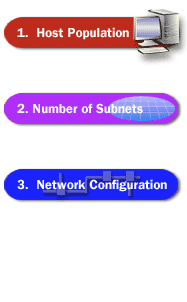| Lesson 2 | DHCP Design Decisions |
| Objective | Recognize DHCP as a configuration solution and the decisions it involves. |
DHCP Design Decisions
The DHCP (Dynamic Host Configuration Protocol) service in Windows Server 2022 streamlines IP address management by automating host configuration across multiple subnets, each with tailored settings. By deploying a DHCP server, administrators can define unique IP address ranges, or scopes, for each subnet, ensuring that devices within a specific subnet receive appropriate IP addresses. This automation eliminates manual configuration, reducing errors and administrative overhead. For example, a scope for Subnet A might assign addresses from 192.168.1.0/24, while Subnet B uses 192.168.2.0/24, each with distinct gateway, DNS, and lease duration settings. The DHCP server dynamically assigns these parameters to clients during network initialization, ensuring seamless connectivity tailored to each subnet’s requirements.
Windows Server 2022 enhances this automation through support for advanced DHCP features like superscopes and multicast scopes, which further optimize multi-subnet environments. Superscopes allow administrators to group multiple scopes under a single logical entity, simplifying management for organizations with complex network topologies. For instance, a superscope can encompass scopes for different departments, each with unique IP ranges and configuration options like reserved IPs for critical devices or custom vendor-specific settings. Additionally, the DHCP service supports policies that enable granular control, such as assigning specific IP ranges or options based on device type or user class. This flexibility ensures that diverse network segments operate efficiently without requiring manual intervention for each client.
The DHCP service also integrates robust failover and load-balancing capabilities to ensure reliable automation across subnets. By configuring DHCP failover between two Windows Server 2022 instances, administrators can replicate scope configurations and lease data, ensuring uninterrupted IP assignment even if one server fails. In multi-subnet setups, this is critical for maintaining consistent configurations across geographically dispersed networks. For example, a branch office on a different subnet can rely on a failover partner to provide IP assignments if the local DHCP server is offline. Combined with tools like IP Address Management (IPAM), Windows Server 2022 provides a centralized platform to monitor and manage these configurations, making it easier to scale and adapt IP allocation as network demands evolve. As an IP configuration scheme grows in both size and the number of configuration options used, it becomes increasingly difficult to manage the manual configuration of network hosts. The DHCP service in Windows Server 2022 provides automation for host IP configuration by supporting multiple subnets with unique configuration options and IP address ranges.
Windows Server 2022 enhances this automation through support for advanced DHCP features like superscopes and multicast scopes, which further optimize multi-subnet environments. Superscopes allow administrators to group multiple scopes under a single logical entity, simplifying management for organizations with complex network topologies. For instance, a superscope can encompass scopes for different departments, each with unique IP ranges and configuration options like reserved IPs for critical devices or custom vendor-specific settings. Additionally, the DHCP service supports policies that enable granular control, such as assigning specific IP ranges or options based on device type or user class. This flexibility ensures that diverse network segments operate efficiently without requiring manual intervention for each client.
The DHCP service also integrates robust failover and load-balancing capabilities to ensure reliable automation across subnets. By configuring DHCP failover between two Windows Server 2022 instances, administrators can replicate scope configurations and lease data, ensuring uninterrupted IP assignment even if one server fails. In multi-subnet setups, this is critical for maintaining consistent configurations across geographically dispersed networks. For example, a branch office on a different subnet can rely on a failover partner to provide IP assignments if the local DHCP server is offline. Combined with tools like IP Address Management (IPAM), Windows Server 2022 provides a centralized platform to monitor and manage these configurations, making it easier to scale and adapt IP allocation as network demands evolve. As an IP configuration scheme grows in both size and the number of configuration options used, it becomes increasingly difficult to manage the manual configuration of network hosts. The DHCP service in Windows Server 2022 provides automation for host IP configuration by supporting multiple subnets with unique configuration options and IP address ranges.
What is DHCP?
DHCP is a broadcast message-driven protocol that allows DHCP Clients on the network to acquire an IP address and TCP/IP client option information
from a DHCP Server. As shown here, there are two components to DHCP in Windows 2000, a DHCP Server service and a DHCP Client. Note: DHCP Server and DHCP Client, with capital S and C respectively, are used throughout this module to indicate a server or client running the DHCP Server service in Windows 2000 or a Microsoft® Windows-based DHCP Client.
- Overarching Design Decisions
When designing a DHCP solution, the network designer must:- Define the requirements for a DHCP solution for the network
- Identify the features provided by DHCP and how these features support the design requirements for the DHCP solution
- Identify the benefits of integration between DHCP and other Windows 2000 services/li>
Design requirements
To develop a DHCP solution, you must determine three elements of your solution. This MouseOver explains these elements and why they're important.

|

|
DHCP Design Requirements
Taken together, this information establishes the subnets you must define and the DHCP Client options to be supplied by the DHCP service in order to allow successful DHCP Client operation on the IP network. Note:
In an IP network that uses DHCP, you must allocate an IP address and configuration information to each DHCP Client to enable IP communication.
On a TCP/IP network, all computers must be configured with the appropriate IP addressing information or they will not be able to participate in network activity. The DHCP Server maintains a database
that includes available and allocated IP addresses for defined subnets and the client TCP/IP options. In the next lesson, you will learn to identify the features provided by DHCP.